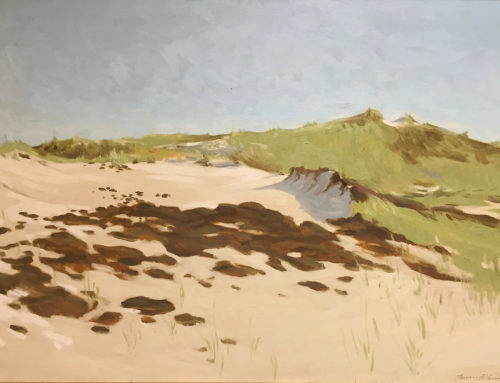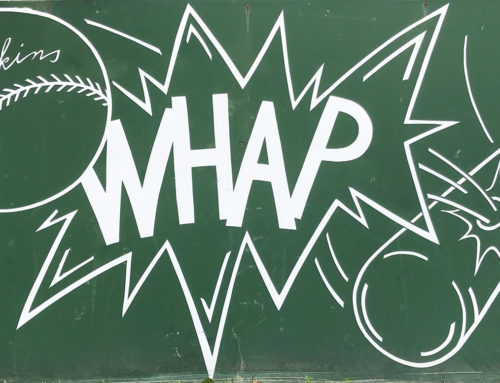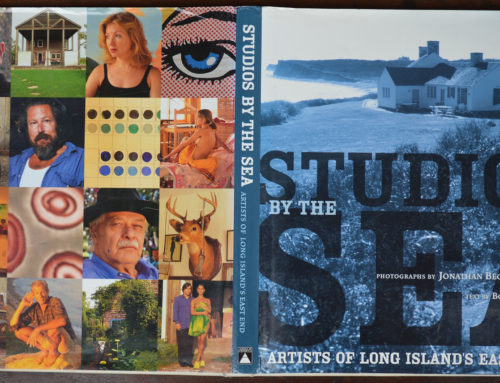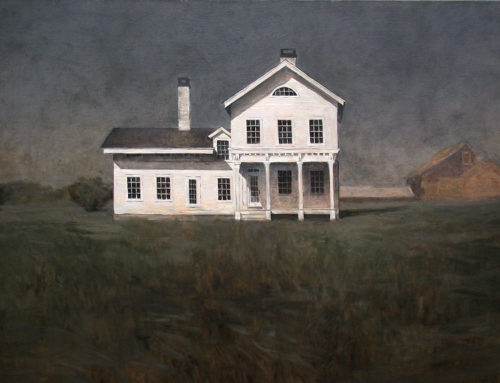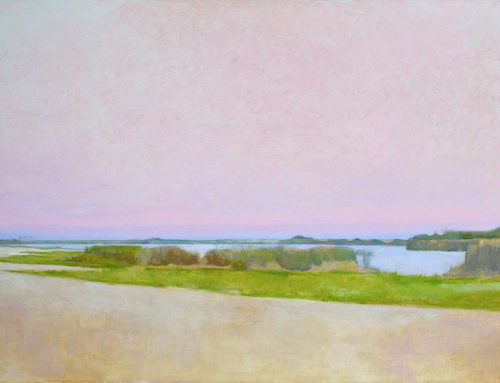In the mid 80s before I moved to Bridgehampton my work was ”abstract”. I wasn’t always an abstract painter. Growing up I related more to the recognizable, imagery and subjects that when painted or drawn you know exactly what it is. Frederic Remington and Andrew Wyeth were my favorite artists as a child. That changed as an undergraduate at Sam Houston State University. I loved life drawing. As well as I could draw the figure, it was a departure point to abstract the figure and that’s when my work changed. When I was in graduate school I wrote my thesis on Painting in Black and White. It focused on Abstract Expressionism. I continued that direction during and after my MFA. Willem De Kooning was my one of my heroes. One day he walked into my studio on campus at the University of Houston with one of my professors, who was showing him around Houston. I didn’t really know what to say. I asked him what he thought of the painting I was working on. He said nothing, not a word. I didn’t know what to think but I learned later he couldn’t hear me. A relief for my ego. Later we ended up meeting at the Rothko Chapel. The Chapel has a quiet reverence that seems to instill calm and inspire one to meditate. A place at the time where anyone could walk in and rarely see anyone else there. At one point my professors were outside talking while de Kooning and I sat there, no one else in the chapel, talking about Rothko, his work and how the two met. de Kooning told me that he was sitting on a park bench in Washington square one night, when Rothko came over and sat on the other end of the bench. de Kooning relayed that he, “felt a little uncomfortable, I wondered if he was, you know.” They struck up a conversation, introduced themselves and realized they’d heard of each other through their paintings but had never actually met. We talked about Rothko’s technique and his intention to work on canvases that size and lay out the somber feeling of these floating color fields as well as living and working in New York during early period of abstract art in New York. Imagine how this young artist, still in school at the time, felt talking to de Kooning about abstract painting. Inspiring none the less. I met other artists when I was at U of H, Red Groomes, Norman Bloom, Macomb Morley, Ellen Lanyon, Ron Gorchov, many who encouraged me to come to New York. From 1978 on I was spending more and more time here until it became a permanent residence. After I had been in New York a few years, somewhere between my first and second solo shows in SoHo, I moved to Bridgehampton and my work started to change again. I was being influenced by the place I had moved to, the East End. My art dealer Hal Katzen thought I was abandoning my direction for another style. He wasn’t happy, questioning my work and causing me to doubt myself. Saying shit like, “I can’t sell that, it has a cross in it. Some people don’t like artworks with crosses in them.” We got into a heated argument one day. Soon after I left the gallery. Sometimes I wish I’d just kept my mouth shut, been more diplomatic, not told him exactly what I thought of him. Although today, when I think about it, I like where I am.
I was alone in my studio, far away from the gallery I’d deserted and New York art scene I was becoming a part of, wondering if I’d made a mistake and lamenting what to do next. One of the first images that seemed to float into my imagination was the interior of a boathouse.

The Boathouse, oil on canvas, 61″x72″, private collection
I was aware of the Baymen and knew that sometimes boats were stored inside for the winter. One day I cranked out a painting that bridged the distance between abstract and representational. Working on a large canvas at night under spot lights in the studio completely from my imagination is entirely different than standing in a landscape and working on a 30”x40 canvas in the tradition of plein air, which by the way I had not tried yet. Opposing schools of thought, two separate primary experiences, one in my opinion neither more legitimate than the other. But this was somewhat of a breakthrough for me. It captured the essence of something inside my subconscious, existing in a space and looking out at the world in a fog.

Boathouse with Hanging Dories, AKA the one with the upside down cross that my art dealer would’t sell, oil on canvas, 58″ x 68″
The boathouse was a real place though I’d never actually seen or been in one. My friend Lana Jokel, a film maker I had met in the city, had a home in Bridgehampton and wanted to come by to see my new studio. She was surprised to see this painting and asked if I had seen the old boathouse off Dune Road in Southampton. No, I had not so one day I drove out to find it. Five miles out Dune Road, it seemed like twenty, I saw this structure on the bay side about 75-100 yards off the road. At first I thought it was someone’s house sitting on the water’s edge. No other buildings were around, this must be it. It was abandoned and looked like no one had used it in years. I pulled to the side of the road to park and walked along a sandy trail thru waist high salt grasses up to the back of the building to peer in. The water side was completely open, the other three sides were clapboard covered and had large window like openings that were probably shuttered at one time.

The Shinnecock boat house, photo by Jonathan Becker.
The space was large enough for a couple of city buses. It had a strange eerie feeling about it but calm within it’s interior, dark and dilapidated yet solid and sturdy, a place that at one time had seen a lot of commercial and or private use but today was a place forgotten. Inspired by it’s presence I came back over and over to study it. I borrowed a friend’s hand held movie camera and went back to film the interior. I panned around the inside for several minutes. It was calm and foggy that day. Looking towards the bay the horizon disappeared. I let the camera run for awhile and when I got back to the studio I plugged the camera into my small Sony Trinitron TV and watched. Over the next few days I set up a large canvas and ran the video over and over while I worked on the second boathouse painting. It’s probably the most accurate description of what it looked like when I found it.

The Boathouse, oil on canvas, 62″x72″ private collection
I’ve done at least a dozen paintings and drawings based on that experience, an ongoing series that I’ve returned to over the years. It’s like visiting with an old friend and sharing memories. It’s comfortable to work on something I’m already familiar with and difficult to divert from the original composition. I still remember the way it looked then. I don’t want to change that. Unfortunately the boathouse is gone now. In 2012 Hurricane Sandy completely destroyed it. I drove by there shortly after the storm, looking for the place where it was. It felt like I’d momentarily lost my bearings. Even the shoreline had changed. The boathouse had disappeared. I’m sure I probably have some old photos in a box that show what it looked like when I first saw it and the video tape would be there too. Mostly I just have paintings to look at.

Chalkboard Boathouse, white pencil on slate chalkboard, 25″x36
The Chalkboard boathouse was one of the last ones I made. I’ve done a few of these in different sizes, a few on old chalk boards kids used to write on or calculate math problems before they had even pencil or paper in schools. It’s interesting to me with this medium I’m not actually drawing the boathouse but the space around the it, the light and reflection in the water. I tried another one on a nautical chart. The boathouse is filled in with heavy layers of pencil to make the drawing darker. The chart represents it’s nautical setting. Or make of it what you feel. Metaphors are comparisons of life.

The Boathouse, George’s Bank, pencil on collage, 24″x35″, private collection. Print available.


